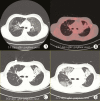Prolonged (6-Month) Shedding of Middle East Respiratory Syndrome Coronavirus RNA in the Sputum of a Lymphoma Patient
- PMID: 32782912
- PMCID: PMC7408226
- DOI: 10.1093/ofid/ofaa292
Prolonged (6-Month) Shedding of Middle East Respiratory Syndrome Coronavirus RNA in the Sputum of a Lymphoma Patient
Abstract
During the 2015 Korea Middle East Respiratory Syndrome coronavirus (MERS-CoV) outbreak, a lymphoma patient developed MERS pneumonia. His pneumonia improved by 45 days after illness onset, but the polymerase chain reaction tests remained (+) for 6 months. However, replication-competent virus was detected by 60 days after illness onset.
Keywords: MERS-CoV; coronavirus; lymphoma; patient isolation; real-time PCR.
© The Author(s) 2020. Published by Oxford University Press on behalf of Infectious Diseases Society of America.
Figures


Similar articles
-
Environmental Contamination and Viral Shedding in MERS Patients During MERS-CoV Outbreak in South Korea.Clin Infect Dis. 2016 Mar 15;62(6):755-60. doi: 10.1093/cid/civ1020. Epub 2015 Dec 17. Clin Infect Dis. 2016. PMID: 26679623 Free PMC article.
-
Replicative virus shedding in the respiratory tract of patients with Middle East respiratory syndrome coronavirus infection.Int J Infect Dis. 2018 Jul;72:8-10. doi: 10.1016/j.ijid.2018.05.003. Epub 2018 May 9. Int J Infect Dis. 2018. PMID: 29753119 Free PMC article.
-
The clinical and virological features of the first imported case causing MERS-CoV outbreak in South Korea, 2015.BMC Infect Dis. 2017 Jul 14;17(1):498. doi: 10.1186/s12879-017-2576-5. BMC Infect Dis. 2017. PMID: 28709419 Free PMC article.
-
Korean Society for Laboratory Medicine Practice Guidelines for the Molecular Diagnosis of Middle East Respiratory Syndrome During an Outbreak in Korea in 2015.Ann Lab Med. 2016 May;36(3):203-8. doi: 10.3343/alm.2016.36.3.203. Ann Lab Med. 2016. PMID: 26915607 Free PMC article. Review.
-
Emerging Developments on Pathogenicity, Molecular Virulence, Epidemiology and Clinical Symptoms of Current Middle East Respiratory Syndrome Coronavirus (MERS-CoV).Hayati. 2017 Apr;24(2):53-56. doi: 10.1016/j.hjb.2017.08.001. Epub 2017 Sep 14. Hayati. 2017. PMID: 32288937 Free PMC article. Review.
Cited by
-
Reinfection and reactivation of SARS-CoV-2.Future Virol. 2022 Sep:10.2217/fvl-2021-0212. doi: 10.2217/fvl-2021-0212. Epub 2022 Sep 26. Future Virol. 2022. PMID: 36176508 Free PMC article. Review.
-
In pursuit of the right tail for the COVID-19 incubation period.Public Health. 2021 May;194:149-155. doi: 10.1016/j.puhe.2021.03.011. Epub 2021 Mar 26. Public Health. 2021. PMID: 33915459 Free PMC article. Review.
-
Beyond early warning: towards greater granularity in the use of event-based surveillance for public health emergencies.BMC Public Health. 2024 Dec 18;24(1):3488. doi: 10.1186/s12889-024-20963-2. BMC Public Health. 2024. PMID: 39696107 Free PMC article.
References
-
- World Health Organization (WHO). Middle East respiratory syndrome coronavirus (MERS-CoV)—Republic of Korea. 2015. Available at: https://www.who.int/csr/don/25-october-2015-mers-korea/en/. Accessed 1 December 2015.

